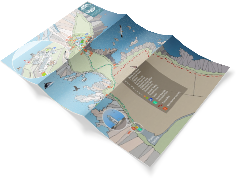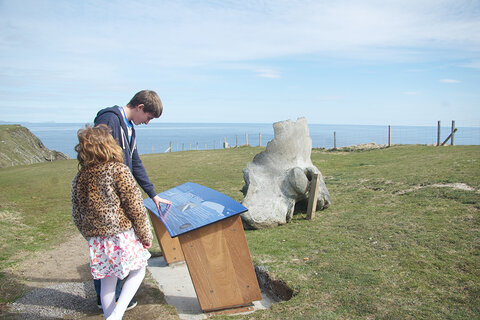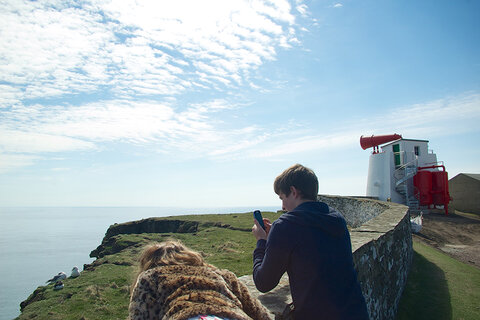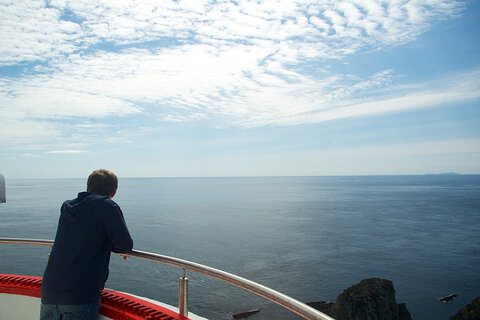Viewing Points
Sumburgh Head, 298 feet above sea level, is an outstanding viewing point with clear views in all directions. There are several points which visitors should take time to enjoy on the walk up the hill, or when exploring the upper areas. These are all marked on the Site Map as VPs.
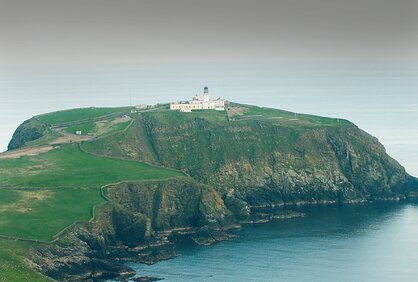 Sumburgh Head rises 298 feet above sea level (Image by Frank Bradford)
Sumburgh Head rises 298 feet above sea level (Image by Frank Bradford)
Viewing Point 1This is the best vantage point to look for whales and dolphins. It takes patience and a big slice of luck but look carefully for anything breaking the surface of the water. Seabirds are a lot easier to see however, and Gannets and Great Skuas can often be seen close inshore from here.
Viewing Point 2
Look down to the cliffs below; from May to early July they host a busy Guillemot colony – this is the closest you will get to Guillemots at Sumburgh. Its proximity is also attractive to researchers, and the Guillemot’s breeding output – the number of chicks raised per pair – is studied at this site annually. You may notice someone studiously looking through a telescope – it takes a great deal of concentration so be sure not to disturb them! Look too for a few pairs of Shags sat on their bulky nests.
Viewing Point 3
This is a fantastic place to see a range of seabirds nesting, or just soaring on the strong air currents. When you have had your fill of seabirds, take a moment to look at the vegetation. Notice the difference in the vegetation on either side of the fence. Coastal habitats are often rich in flowers because of the nutrients received from the salt spray. This rich vegetation is attractive to sheep and is often grazed down like a billiard table. The sheep can’t get to the cliffs though and here flowers can be abundant. In early spring look for the delicate blue Spring Squill and the pink Thrift, otherwise known as Sea Pinks.
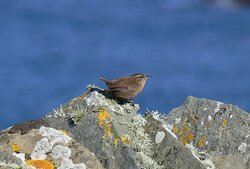 Wren, at Sumburgh Head
Viewing Point 4
Wren, at Sumburgh Head
Viewing Point 4
The walls, or dykes as they are known locally, are attractive to small songbirds. Listen or look carefully and you might see or hear Meadow Pipit, Starling, Twite, Wheatear and Wren on your way up to the Head. All of them breed at Sumburgh. The Wren is particularly notable as it is a different subspecies to the one you see on Mainland. It is larger, darker and has a flatter song which reverberates around the cliffs.
Viewing Point 5
Please take care of vehicles turning at this point. From here it is clear to see why Sumburgh Head has been a strategic defence point since the Bronze Age and Iron Age. There are clear lines of sight up either side of the Shetland Coastline; you can see north west to Jarlshof, Old Scatness and Toab, and north east over to the Ness of Burgi Fort at Clevigarth and Eastshore.
Viewing Point 6
In Spring and Summer, this is the place to spot seabirds – Puffins, Fulmars and Razorbills should all be on show but spare a moment for lichens too. On the wall in front of you there is bright orange Xanthoria and Caloplaca, straggly green Ramalina and whitish Tephromela with its tiny black mushroom-like fruiting bodies. Study them more closely by turning your binoculars the wrong way round and getting them in close to the lichens. These lichens are testament both to how old the dyke is, and how clean the Shetland air is.
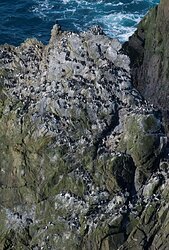 Guillemots nest on the rock stack
Viewing Point 7
Guillemots nest on the rock stack
Viewing Point 7
Look down at the large offshore stack in front of you. In May and June it is plastered in Guillemots but it’s not always a safe place to be. In June 2000 a huge storm washed all the eggs and chicks off of the stack! Puffins nest in their burrows very close to the top of the cliff in this area. They will sit very close and are usually very happy to pose for the camera! You might notice the chute in front of you. In days of old, this was used to dump lighthouse rubbish (usually, but not exclusively ash and human(!) waste) over the cliffs. Fortunately we are all a bit more environmentally aware now and this practice was discontinued many years ago!
Viewing Point 8If you are lucky, the slopes below you will be carpeted with Puffins. If not then it is likely that they are either all out at sea fishing, or a predator – usually a Great Skua or large gull – has just flown over looking for an easy meal. Sometimes Puffins form large ‘wheels’– a circling flock – over the colony. The large numbers involved are thought to confuse would be predators. Each Puffin joins the flock before landing at the colony.
Viewing Point 9
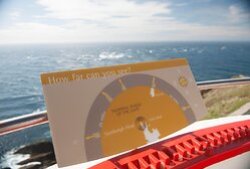 How far can you see from the top of the Foghorn Tower? (Image by Frank Bradford)
Look around – all you can see from the vantage point atop the Foghorn Tower is sea; but transport yourself back about 400 million years and you would be stood in the foothills of a vast, eroding mountain chain looking over a baking-hot desert. At this time Shetland was situated close to the equator. The Old Red Sandstone rocks of Sumburgh Head formed in this environment.
How far can you see from the top of the Foghorn Tower? (Image by Frank Bradford)
Look around – all you can see from the vantage point atop the Foghorn Tower is sea; but transport yourself back about 400 million years and you would be stood in the foothills of a vast, eroding mountain chain looking over a baking-hot desert. At this time Shetland was situated close to the equator. The Old Red Sandstone rocks of Sumburgh Head formed in this environment.
On a clear day you can also see the island of Fair Isle to the south east. This is one of the most famous migrant hotspots in Europe and a Bird Observatory has been established on the island since 1948. Over 380 species of bird have been recorded on this tiny island!
Viewing Point 10
Look down at the offshore rocks and stacks to your right. This is the best place to see seals at Sumburgh. They may be in the water or hauled out on the rocks. Look carefully as they are well camouflaged when out on the rocks. Grey Seals can sometimes be heard ‘singing’.
Viewing Point 11
The outside deck of the Lighthouse Tower is the prime viewing spot for any visitor to Sumburgh Head. When tours of the Lighthouse Tower are available, this vantage point will give you the view of a Lighthouse Keeper with no obstructions as far as the eye can see.
Viewing Point 12
The panoramic windows of the Stevenson Centre provide stunning views whatever the weather. Surely the best view from a classroom anywhere in the world! Look over to the imposing bulk of Fitful Head, or down to the bird colonies nesting on the rocks. Look to the south west and you can see the bushes in the walled park, which are an important feeding and sheltering area for birds during their spring and autumn migration. Watch planes arriving and taking off from Sumburgh Airport; and on a wild day, enjoy all of this from the warmth and comfort of the indoors! Please not that access is not always available if this room is in use by another group.
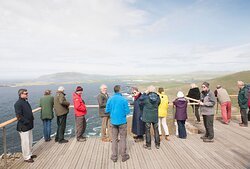 The viewing platform is very popular with visitors
Viewing Point 13
The viewing platform is very popular with visitors
Viewing Point 13
A platform with a view, and what a view! To the north west you can see the low peninsula of Scatness – look carefully and you might be able to make out the iron-age fort near its tip. The large land-mass behind reaching over 900 feet is Fitful Head. To the north you can see the telecommunications tower on the Ward of Scousburgh and to the north east you can see the ward of Bressay and the nose-shaped Noup of Noss, with its 600 foot cliff dropping straight into the sea. This is also an ideal place to take advantage of the knowledge of RSPB staff and volunteers who are on duty, providing the use of optical equipment to get a closer look down at the breeding colonies.

